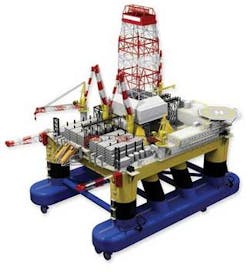Harsh environment semi provides improved stability and deck space
Grenland Group’s P099 semisubmersible rig concept is designed for drilling ultra deep holes in ultra deep waters, and to operate in ice-laden waters, giving it all-round capability for the most demanding conditions.
The rig, with a variable deck-load of 7,000-7,500 metric tons (7,716-8,267 tons), can operate in water depths of up to 3,000 m (9,842 ft), drilling wells up to 12,000 m (39,370 ft) deep. Grenland also has a strong focus on optimizing the rig’s dynamic positioning performance, so the power requirement for station-keeping is minimal.
Anchor equipment for an eight-point mooring can be accommodated, either as a permanent complete feature or for prelaid mooring system purposes.
Visually, the most unusual feature of the P099 design is inward inclination of the four central columns. The inventor of this concept was Thor Haavie, chief designer of the P099 and director of research and development at Grenland Group Technology.
He drew extensively on his previous experience for this project. In the 1970s he designedUncle John, the first DP semi. This rig, a diving support vessel and the smallest semi in the offshore fleet, was delivered in 1977. He followed this with Stadive, a multifunctional service vessel also employing DP station-keeping. On delivery in 1982, this rig - since renamed Louisiana - was the largest DP semi then built.
Stability issues have also featured prominently in Haavie’s career. In 1982-85, he worked as a consultant for the Canadian government as part of the inquiries into the capsizing of theOcean Ranger drilling rig, and drew up proposed new stability rules for semis. In this period he also became well acquainted with the design requirements for rigs operating in ice-congested waters.
In the P099 design, three major benefits arise from the inclined central columns. Firstly, these represent steel applied directly in the paths of the major global forces resulting from centrally acting drill-floor loads such as tensions, derrick and rig equipment. The upshot is a weight saving believed to be more than 700 metric tons (772 tons). This translates into additional deck-load capacity.
The inclined columns make a significant contribution to the vessel’s transverse stability characteristics, due to the beneficial effect of their waterplane area. This is most pronounced at shallow vessel draughts when the vertical position of the vessel’s center of gravity is highest.
A third benefit is that, with their comparatively large diameter of 9.5 m (31 ft), the inclined columns also provide storage space for powder tanks and other equipment which cannot be provided by traditional, small diameter bracing support systems for derrick weights and tension loads.
The eight columns have double skin in areas prone to ice collision. As this feature was included in the original design criteria, it has not resulted in any steel weight increase.
P099’s DP performance is improved substantially by the emphasis paid to minimizing drag forces.
Only eight drag elements - the eight columns, which all have circular cross-sections - cross the air/water interface. The main subsurface structural elements - pontoons, columns and trusses - are few and shaped to give low values of current and wave-induced forces at all drafts. The result is a power requirement for DP purposes some 25% less than for other semisubmersible designs of similar size, Haavie says.
P099 is a DP Class III vessel, with four engine rooms, four high-voltage switchboards and eight fixed-pitch, variable speed thrusters. The vessel can maintain position with high accuracy relative to a seabed target in extreme conditions such as 90 knots wind speed, 9 m (30 ft) significant wave heights, and 1.5 knots current speed.
Equipment is provided for integrated remote-operated mechanized pipe-handling, including two knuckle-boom cranes for handling drillpipe, casing and riser joints on the upper deck. There is storage capacity for up to 3,000 m (9,842 ft) of riser and 15,000 m (49,213 ft) of drillpipe and casing on the upper deck.
The rig has a derrick with two operations centers: a main drilling center and an auxiliary center. Electrically driven drawworks serve each center. The drawworks for the main drilling center has active heave compensation capability. The derrick has a vertical racking capacity of about 7,500 m (24,606 ft) of drillpipe and drill-collar, and 2,200 m (7,218 ft) of casing racked in doubles.
The drillers’ cabin is a state-of-the-art three-man cabin with automated drilling instrumentation and drilling control system.
Inclined center column geometry allows implementation of an ‘N-line’ tension system. According to the designers and manufacturers, the total equipment weight of this system is some 300 metric tons (331 tons) lighter than a traditional tension system. Tension system component weight savings and the low suspension points of the tension cylinders should lead to increased deck-load carrying capacity of 400-500 metric tons (441-551 tons) compared with a traditional arrangement.
The design objectives set for P099 have been achieved, Haavie says. In particular, the low volume of steel - in total about 15,000 metric tons (16,535 tons) - gives it a competitive acquisition cost in relation to its operational capabilities. It also offers low operating and maintenance costs, good motion responses and little mechanical or weather-related downtime.
“We do not want to be perceived as a potential rig owner or competitor to our rig-owning clients,” adds Bjørn C Anker, executive vice president of Grenland Group Technology. “Our scope would typically be that of engineering and project management.”

